Help Build a Homegrown National Park
Author: Jim George
Imagine a huge, interconnected National Park that provides vital habitat for birds, pollinators, and other wildlife. A park that includes your own yard. A park that helps mitigate the climate crisis. A park that may take a step toward saving us from an ecological collapse that some see as the start of a sixth mass extinction. Is this some sort of fantasy? Not according to Doug Tallamy in his latest book, Nature’s Best Hope: A New Approach to Conservation that Starts in Your Yard. He imagines “Homegrown National Parks” in our country and other nations that will go a long way to restoring so much that has been lost as humans have built sprawling cities and suburbs and devoted so much of the land to grazing and industrial-scale agriculture. It’s become a land stripped of native habitat; taken over by invasive species of plants, insects, and other animals while we lose our own native species; polluted without regard to protecting life; and poisoned by overuse of pesticides.
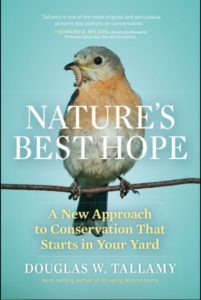
The beauty of Tallamy’s Homegrown National Park is that it involves your own landscape and the landscapes of businesses, towns, and the cities in which you live. Certainly, our current national parks, national wildlife refuges, state parks and many other local parks and preserved pockets of land remain a vital part of this picture. But they are fragmented and often under attack. A Homegrown National Park would provide the critical connectivity of native habitat that birds and other wildlife need to survive. As Tallamy writes: “What if each American landowner made it a goal to convert half of his or her lawn to productive native plant communities? Even moderate success could collectively restore some semblance of ecosystem function to more than twenty million acres of what is now ecological wasteland.” According to Tallamy, twenty million acres would be larger than “the Everglades, Yellowstone, Yosemite, Grand Teton, Canyonlands, Mount Rainier, North Cascades, Badlands, Olympic, Sequoia, Grand Canyon, Denali, and the Great Smokies Mountains National Parks” combined.
We need to get beyond the notion that somehow we are separate from the natural world, that we don’t need to have it all around us, that it is fine to confine it to parks, refuges and preserves. For we are not somehow separated from nature but completely intertwined with all life around us in a deeply connected way that provides the oxygen we breathe, the clean water we drink, and the food that we eat. And the natural world is in decline with extinctions of species from insects to larger animals occurring at an alarming rate. Life as we know it is under threat unless we take action.
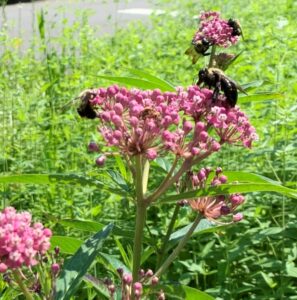 Native bees are in severe decline.
Native bees are in severe decline. And one way you can take action is to participate in creating a Homegrown National Park. The solution is simple because it starts with what you have control over, your yard. Let’s delve into some details of how you can help be a part of a Homegrown National Park. Along the way, I will note how these efforts dovetail with the work of the New Hope Audubon Society (NHAS) and its Bird-Friendly Habitat Committee, which Barbara Driscoll and I co-chair. I also will provide links to relevant NHAS blog articles and other resources so you can take a deeper dive into any of these subjects. Here are Tallamy’s ten ways that you can participate along with my notes and thoughts about each of his ten points.
“SHRINK THE LAWN”
Lawns are not native and require water, fertilizer, herbicides, and insecticides and need frequent mowing to have that perfect look promoted by the ads from the companies selling lawn products. Lawn care harms the environment, and lawns don’t support our native insects that are a vital link in the web of life since they pollinate our plants and provide the food that birds and other wildlife need to survive. We’ve allowed lawns to become the definition of beauty for a property as a holdover from centuries past where only the rich could afford to have non-productive acreage in a mowed lawn. You should try to reduce lawn area and turn that land into something productive for wildlife by planting native plants. Grass can have its uses since it holds up well to foot traffic and can be used for paths through your garden. Borrowing from another author, Tallamy suggests you should think of your lawn less as wall-to-wall carpeting and more as area rugs. Reducing lawn area is also a point we stress to homeowners on our NHAS Bird Friendly Habitat Certification visits.
“PLANT KEYSTONE GENERA”
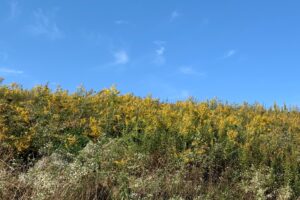 Field of goldenrod and frost aster.
Field of goldenrod and frost aster. Birds need to feed their young on a high protein diet of insects or other animal prey. For example, Carolina Chickadees may need 6,000 to 9,000 caterpillars to fledge one nest of chicks and then many more as they continue to feed the fledglings. Tallamy has developed the case for the use of native plants to support both pollinators and other insects in his previous two books. Now in his third, and perhaps most important book, he’s developed the concept of keystone genera of native plants to describe the native plants that support the most moth and butterfly caterpillars, the most nutritious food for baby birds. Tallamy writes, “Landscapes that do not contain one or more species from keystone genera will have failed food webs, even if the diversity of other plants is very high.”
Thus, you definitely should try to have some keystone plants on your property along with your other native plants. We’ve developed a Keystone Plants spreadsheet that takes all the larval host plants from the New Hope Audubon list of recommended native plants and then rank orders them from the most caterpillars supported to the least. The “keystone” plants in each category are the ones at the top of each section. You can review the keystone spreadsheet and then look up detailed information from our recommended native plant lists. As examples of great plants to have, oaks (Quercus genus) host 488 caterpillars, the most of any trees, and goldenrods (Solidago genus) host 102 species, the most of any flowering perennial. Note: goldenrods have gotten a bad rap for causing allergies, but they don’t! Instead, it is wind-pollinated ragweed, which blooms at the same time, with its inconspicuous, tiny green flowers that is the real culprit.
“REMOVE INVASIVE SPECIES”
Invasive plant species crowd out the native plant species that support our native insects and for the most part, support very few insects themselves. Many invasive plants are escapees from yards where we’ve planted them simply for their decorative value. Several NHAS blog articles address the very serious issue presented by invasive plants in much more detail and give information on their removal, so I’ll refer the reader to these articles including: “The Alien Plant Invasion,” “Invasive Plants are NOT for the Birds,” and “Now Is the Time to Remove Invasive Plants.”
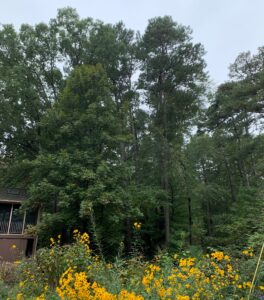 Wooded area in my back yard.
Wooded area in my back yard. “BE GENEROUS WITH YOUR PLANTINGS”
An important part of landscape design with native plants is to have all the layers present because each in turn supports its own population of specialist insects and pollinators. Birds also specialize in which layers of the landscape they nest and feed. It starts with the canopy trees, then down to the understory trees, the shrubs, the perennial flowers, the grasses, and the vines. This is so important that having all layers present in your yard is required to be certified in our Bird Friendly Habitat Certification program. Try to simulate native plant communities in the Piedmont that originally consisted of a mix of woods and prairies. I have less than 1/3 acre in an older neighborhood in Chapel Hill and still am able to have a wooded area in the backyard with 12 species of native trees, important forest edge environments as the woods transitions to open areas, and some sunnier areas in front where garden beds can be planted more like Piedmont prairies. Adding a native plant garden to even the smallest of lots can make a difference, since your lot will interconnect with your neighbors and with other neighborhoods as they become part of the Homegrown National Park.
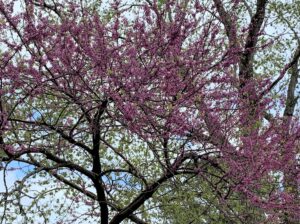 Redbuds offer vital nectar for bees in early spring.
Redbuds offer vital nectar for bees in early spring. Plant not just one tree but several together to form a more forest-like environment and have the trees lock their roots together to prevent toppling in a storm. Test out new perennials with a few plants of a species, maybe 3 to 5 in a location, and if they do well, increase their numbers until you have a drift or significant clump of that species. This makes it easier for pollinators to find and browse their flowers with less energy expended and models the beauty of a natural landscape. Plant natives that bloom sequentially from March to October. Bees and other pollinators depend on a food source throughout the growing season so you will need to plant a variety of flowering plants, including trees, that bloom at different times of the year. My blog article titled “To Every Plant There is a Season” addresses this in detail.
“PLANT FOR SPECIALIST POLLINATORS”
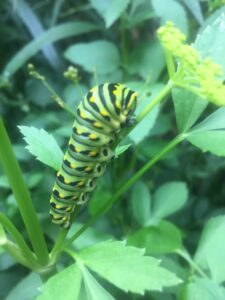 Black swallowtail caterpillar on golden alexander – photo by David George.
Black swallowtail caterpillar on golden alexander – photo by David George. The caterpillars of butterflies and moths have developed methods to overcome the defenses that plants have evolved to keep from being eaten, but many only can use a narrow range of plant species to feed. Monarch butterflies are a well-known example since they only lay their eggs on milkweeds. Black swallowtails have to lay eggs on a member of the carrot family, and golden alexander is the only species in that family on our recommended list of native plants for this area (note: they also love parsley). For more information about pollinator gardens and what plants support what pollinators, check out NHAS’s blog articles, “Your Yard Is Your Pollinator Garden” and “Creating a Pollinator Friendly Yard” and the NC Botanical Garden’s brochure, “Creating Your Pollinator Garden”.
“NETWORK WITH NEIGHBORS”
Tallamy cites one example of a person influencing a neighbor whose yard was the epitome of unnatural and just didn’t get why that could be a problem. The key was monarch butterflies. After the neighbor was told about their plight, he planted some milkweed, and sure enough the monarchs came. He was very excited to see and to be helping monarchs, so then he planted more milkweed. He was hooked.
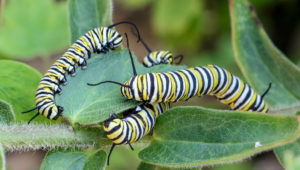 Monarch caterpillars on milkweed – photo by Barbara Driscoll.
Monarch caterpillars on milkweed – photo by Barbara Driscoll. Most of us probably have neighborhood email listservs or have neighbors that use apps like NextDoor, and these can be great places to start a conversation about restoring native habitat for bird, pollinators, and other wildlife through the use of native plants and removal of invasives. You even can refer neighbors to this “Home Grown National Park” blog article as a starting point. Another good way to network with neighbors is to share native plants. I explore this idea further in my recent blog article, “Keeping Up the Tradition of Passalong Plants”.
“BUILD A CONSERVATION HARDSCAPE”
In addition to plants, Tallamy recommends making your yard more friendly to wildlife by taking the following steps:
- Use covers over deep window wells to prevent small creatures, e.g. toads, from getting trapped and starving to death.
- Rather than keep floodlights and other bright outdoor security lighting on all the time, use motion sensor lights. This will keep your lights from being traps for moths.
- Mow grass no lower than 3 or 4 inches for a healthier lawn and potentially to spare wildlife like box turtles. After years of working on the habitat in my yard, I’ve been seeing box turtles for the first time this year and even a chipmunk! Also avoid mowing near dusk when you might be mowing down some creatures that emerge at twilight.
- Use a bubbler water feature to attract birds. Make sure though that it is placed so it does not put your birds at risk for cat predation.
- Use many bee hotels with only 4 or 5 holes each instead of one large one to make it harder for predators and parasites to find the bees in one location and for diseases to spread.
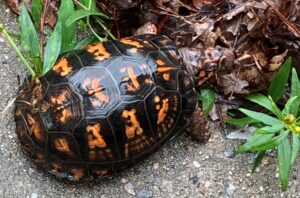 Eastern box turtle in my yard.
Eastern box turtle in my yard. Two things Tallamy does not mention, but we consider very important in NHAS, are to prevent bird collisions with windows and to keep your cats indoors or provide safe spaces outdoors. See the NHAS blog articles, “Preventing that Dreaded Thump” and “Living with Cats and Birds” for details.
“CREATE CATERPILLAR PUPATION SITES UNDER YOUR TREES”
Many insects are dependent on leaf litter for at least part of their life cycle. Whenever possible, let the leaves stay where they fall. It’s especially important not to have grass under trees since most of the caterpillars that feed in the trees then drop to the ground to form pupae in the leaf litter or soil under the tree as they overwinter. Fireflies also pupate in the leaf litter, emerging only to breed in the summer and delight us with their evening show. Tallamy states, “if you have more leaves each fall than your beds can accommodate, that’s a good sign that your beds are not large enough”. Also important is to leave some fallen branches, often referred to as “nurse logs,” to provide habitat for other species. These topics are explored in detail in two NHAS blog articles: “Leave the Leaves” and “Littering with Leaves.”
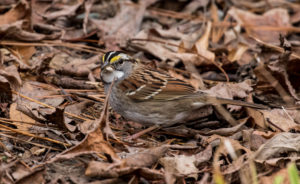 White-throated sparrow feeding in leaf litter – photo by Barbara Driscoll.
White-throated sparrow feeding in leaf litter – photo by Barbara Driscoll. “DO NOT SPRAY OR FERTILIZE”
In general, you should try to minimize or eliminate pesticide use in your yard. It’s a requirement of our Bird Friendly Habitat certification program that you do so. Native plants have evolved to coexist with the native insects and will not be damaged by their feeding. Even though oak trees support 488 species of native caterpillars, most of us will not see any sign of their feeding on the oak leaves. Mosquito spraying uses broad spectrum insecticides that can kill or weaken anything flying at the time of application. The best way to deal with mosquitoes is to eliminate their breeding sources in yours and neighbors’ yards. The issue of spraying for mosquitoes and alternatives to spraying are explored in detail in the blog article, “The Invasion of the Asian Tigers”
Along with avoiding use of pesticides yourself, you should also try to avoid buying plants treated with neonicotinoid insecticides or “neonics” for short. These systemic insecticides are taken up through the roots of the plants after a soil drench and remain in the tissue and pollen of treated plants up to several years. They have been shown to harm the insects browsing on their leaves and the bees and other pollinators exposed to the pollen. We are working with a number of local garden centers to stop selling plants treated with neonics or to at least identify any treated plants to the customer. When shopping for plants, you will need to ask if the plant has been treated with neonics before buying. Ideally, the plant should have been treated with only topical insecticides and not have been treated with any systemic insecticides that can be absorbed into the plant tissue. You can find a list of recommended garden centers on our website, but even at these places you will need to ask about neonics. For more detail on neonics read the blog article: “Neonics, Bee-Killing Insecticides that also Harm Birds.”
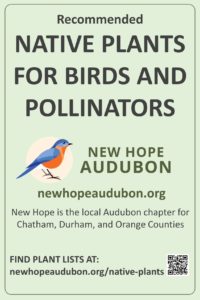 NHAS sign given to our recommended garden centers.
NHAS sign given to our recommended garden centers. Tallamy’s recommendation to avoid fertilizing is less obvious, but native plants have adapted to growth without added chemical fertilizer, and simply mulching with leaves, nature’s fertilizer, can usually suffice. High-nitrogen, inorganic fertilizers run off into our streams and rivers from our yards and create deadly algal blooms in our lakes. Jordan Lake is considered highly polluted now partially due to storm-water runoff. If you must fertilize, only use organic fertilizers until you build up your soil, if needed, and your plantings are self-sustaining. Use a mulching mower to add grass clippings back to the soil instead of bagging them for pick-up. That also saves you a lot of unnecessary work! Grass clippings quickly decay and do not contribute to problems with thatch.
“EDUCATE YOUR NEIGHBORHOOD CIVIC ASSOCIATION”
If your house is in an area that is controlled by a Homeowners Association (HOA), their rules can be a significant barrier to having complete control over what you plant in your yard. Many HOA boards of directors have bought into the concept of yards needing to have a significant portion of frequently mown lawn to meet their standards of beauty. Try to get on the board of the HOA and convince other board members that having non-native lawn grass is a standard foisted upon us by the lawn care industry and that native plantings are critical for the environment and can have greater beauty. If the HOA does not have a landscaping subcommittee, volunteer to form one. On the flip side, HOA’s can be very helpful in creating lists of what can be planted and what should not. They should ban the planting of invasives and strongly favor the planting of native species. Again, your involvement will be critical.
New Hope Audubon has been helping individuals work with their HOA’s by attending meetings, doing presentations to these groups, and other outreach. We also have been working with co-housing groups by doing certification visits for their entire community. Our Bird Friendly Communities program extends our work beyond local neighborhoods by working at the town, city and county government levels on their landscaping ordinances and plant lists and encouraging them to stress the use of native plants, remove invasive plants from their lists, create plans for invasive plant control, and more. We also are working with small businesses on their landscaping and with larger businesses through our new Corporate Board Friendly Habitat Certification program. Please contact us for more information on any of these programs at: [email protected].
Some final words. Don’t be deterred or overwhelmed by the thought that this is just too much to undertake. You can start by just planting a few native plants this fall since this time of the year is a great time to do so. Over the winter months, plan to start removing a few invasive plants since most invasive plants are evergreen and easier to identify then. Just take one step at a time and together we can build a fantastic Homegrown National Park.
“If we can destroy habitat with blinding speed, we also have the intelligence, knowledge, and ability to restore it. It remains to be seen whether we have the wisdom to do so.” – Doug Tallamy, Natures Best Hope.
“It’s simple: By gardening with native plants, no matter where you live or how small or large your space is, you can help sustain wildlife.” – Doug Tallamy, Bringing Nature Home: How You Can Sustain Wildlife with Native Plants
Note: This article builds on the concepts presented in my earlier blog article, “Saving the Birds, One Yard at a Time.” That article was based on a talk by Doug Tallamy at the NC Botanical Garden given well before “Natures Best Hope” was published. It had a focus on preventing an insect apocalypse but led to several similar recommendations. This article takes a different focus and adds all of the new concepts presented in the latest book and all of the resources NHAS has developed since then.
« Back to All Press